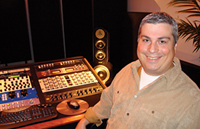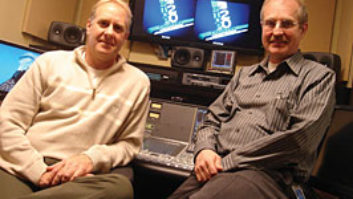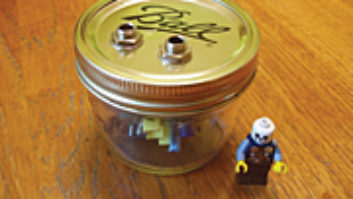
Engineer Joe Palmaccio in his studio The Place…For Mastering. Palmaccio recently restored a box set of previously unreleased Hank Williams recordings.
Nashville is quieter than New York or Los Angeles. That’s part of its appeal. Nashville mixes, though? Suffice to say that the Loudness War has spread to bucolic Middle Tennessee.
“Country music that’s distorted? That’s just wrong,” says Jim DeMain, who runs Yes Master in Nashville. “Every mastering engineer would breathe a sigh of relief if we could just dial it back. There’s not one mastering engineer here thinking, ‘I can’t wait to trounce this record into oblivion.’”
That’s not to say that every Nashville record is being trounced, or that Emmylou Harris is suddenly trying to out-volume the Metallica album that has been getting so much attention of late for supposedly hitting the loudness guardrail. But Music City mastering houses are facing the same issue that is causing hands to wring and brows to furrow across the country. Artists and producers come in holding a favorite album, proudly hand it to the engineer, and say, “I want it this loud.” And every year, “this loud” goes up. A few years ago, “this loud” became “too loud” in the minds of many, yet the war goes on.
“I don’t know who came up with the term ‘The Volume Wars,’” DeMain says, “but I started thinking about that term. In any war, no one really wants to be there, on either side. So why are we putting up with this? We’re the guys doing it. Maybe we could have a summit meeting, and say, ‘These are the new standards of volume.’”
DeMain’s suggestion is something like unilateral disarmament. It’s a wonderful idea, in the “Imagine all the people/Living life in peace” kind of way. The trouble is that mastering is about pleasing the customer, and the customer is big into loud these days. The other trouble is that “loud” isn’t just “loud”; it’s also sometimes squashed and lifted until it resembles a bad plastic surgery. The microdynamics that make people tap their feet, dance and feel a physical response are smashed. The macrodynamics — the things that make the listener shake a fist and scream, “Yes” when the verse cedes to a sing-along chorus — are pounded. And the complexities of a mix get whitewashed like Aunt Polly’s fence in The Adventures of Tom Sawyer.
“I call it ‘collapsing,’” says Joe Palmaccio, the engineer at The Place…For Mastering, located in the Berry Hill section of town. “The music comes out of the speakers and feels like it’s folding back in. And people who are listening, think, ‘I don’t like this record.’ It’s not that they know exactly why they don’t like it. But they don’t.”
Andrew Mendelson heads Georgetown Mastering on Music Row. “People don’t listen, and say, ‘That record is distorted and fatiguing.’ They’re just like, ‘I don’t like listening to that.’ It is subconsciously impacting the music industry. We have a nice room for listening here at Georgetown, and some of these things coming out now are just really hard to listen to. We’ve been mastering the Neil Young Archives series lately, and I can listen down to those, and when I’m done with an album I can press Play again or move on to the next one, and enjoy it either way. But with too many modern records, you’re like, ‘I need a break.’ You should never need a break from music.”
Engineers talk about a mix’s “sweet spot,” where the limiter holds things in place but still allows a pulse and a dynamic punch.
“Lately, I’ve been into the Sony Oxford limiter,” DeMain says. “Of all the ones I’ve tried, that one does something where it keeps the low-mid transients intact. Some limiters smear that away, but with the Sony you can hear deeper into the mix. You can find that sweet spot. But, unfortunately, that spot is usually several dB quieter than what it needs to be to be ‘competitive.’”
Palmaccio’s business ranges from working on archival projects such as the recent box set Hank Williams: The Unreleased Recordings (Time Life) to new-world work with Melinda Doolittle, Jewel, Lori McKenna and Dion. When confronted with an artist or label that wants something at a volume that causes fatigue and distortion, he likes to try to illustrate the situation.
“I was doing a record with a band out of New York recently and they were on the fence about how much to push the record,” Palmaccio says. “I said, ‘Here’s the thing with digital limiters: We can move the mouse and turn it up and turn it up some more.’ And I kept shoving it up until they realized, ‘Wow, it sounds worse and worse.’ It was an interesting exercise to show it to them and they understood what was going on.”
DeMain, Palmaccio and Mendelson took note and found solace in the fact that the Metallica mastering was a story in the mainstream media: If music-buyers are beginning to notice the impact of limiting in the name of loudness, then perhaps the industry will allow a scaling back.
“Has a consumer ever complained that a record was too quiet?” Mendelson asks. Survey says…doubtful.
For another mastering engineer’s perspective on the “loudness wars,” read Gavin Lurssen’s essay on page 40.
Send Nashville news to
[email protected]


